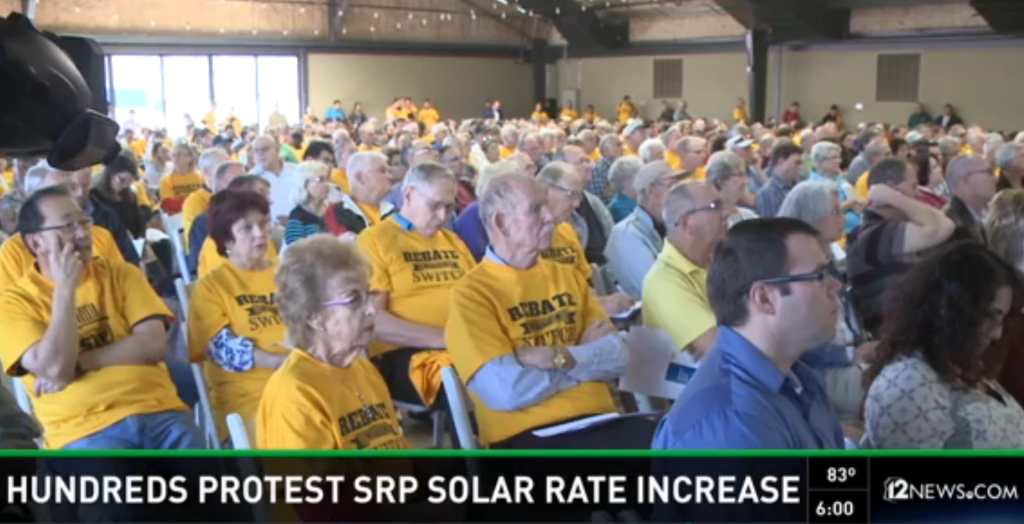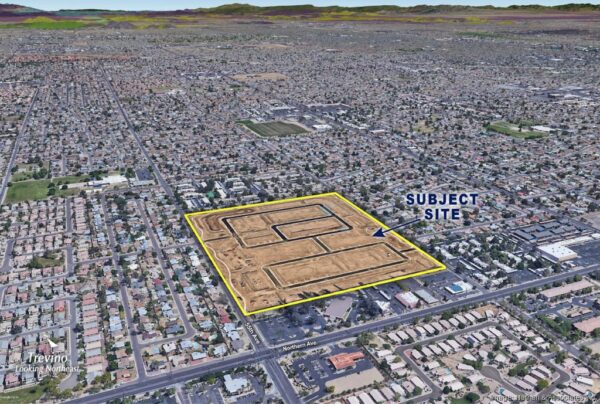
At least 800 people gathered at a meeting hall in Tempe, Ariz., many of them voicing opposition to the Salt River Project‘s proposed electric rate increases, especially charges for solar customers that would be among the highest in the nation.
Under SRP’s proposal, customer bills would go up by an annual average of 3.9%, or about $4.60 per month, for the typical household. The plan would also result in an increase in average new solar customers’ rates of almost $80 a month with new demand and service charges, though a lesser figure of $50 has been frequently cited by opponents and by SRP itself.
The utility maintains the impact of the demand and service charges will be significantly less because of corresponding decreases in energy charges for new solar customers.
Still, a large number of people who could get into the 500-seat meeting hall for the SRP board of directors’ meeting objected to the stiff solar charges that SRP management proposes to levy on future solar customers. Because of their large numbers, many who attended the Feb. 9 meeting were forced to stand outside the meeting hall, which is at an SRP-owned country club.
The SRP board listened mostly in silence to hours of presentations and protests and decided to recess the meeting until Feb. 12, according to Arizona PIRG Executive Director Diane Brown, who attended the meeting. “Typically, they try to listen to what folks have to say and then have management address any larger themes brought up during public comment,” Brown said.
The 14-member board is scheduled to make a decision at its Feb. 26 public meeting on whether to accept or modify its management’s proposals and it remains to be seen whether public opinion will influence their decision-making.
Yet Brown said she has never seen such a large turnout for a rate hearing. “I’ve been working one way or another on energy issues for over a decade and I have never experienced such a diverse, broad and deep set of commenters on any issue before that body,” she said.
The meeting was held at SRP’s PERA Club, a private country club for employees and families of SRP. The 83-acre club houses a social center, employee store, fitness center, swimming pool, game courts and fields, and it offers children’s programs, fitness classes, business meetings, sports leagues and parties.
Brown said she and other visitors were surprised by the luxurious accommodations. “Do they really need the facility? Again, they are a nonprofit,” she said. “Many of us in the room thought, ‘Well, look at the perks they are providing.'”
SRP explains proposed demand charge
SRP Manager of Pricing Design John Tucker said in an interview prior to the hearing that the demand charge would be only for new distributed generation customers. SRP does not yet assess demand charges on its residential customers, but it does have them for non-residential rates.
The demand charge would be assessed based on net-metered demand after subtracting the contribution that a distributed generation system makes to the grid during on-peak hours. The net-metered demand charge would be about $66 per month for an average solar customer that has a 7-kW system, Tucker said. The charge would not be assessed on SRP’s 15,000 or so existing solar customers for 10 years. If those grandfathered-in customers sell their homes before then, the new owners would pay the charge regardless of whether they own or lease their solar systems, Tucker said.
A number of utilities, including neighboring Pinnacle West Capital Corp. subsidiary Arizona Public Service Co., have had residential demand charges for years, but no utilities to date have implemented a demand charge only for distributed generation solar customers. Some utilities across the U.S. are considering proposals similar to SRP’s, he said.
Additionally, SRP managers are proposing to institute a separate service charge only for solar customers that have or will interconnect after Dec. 8, 2014, because there are distribution costs on top of those of nonsolar customers, Tucker said. That charge for solar customers would typically be $12.44 per month, but for a handful of large solar customers, the charge would be $25, he said.
“This is a new mechanism. SRP has been collecting for those costs in the full kilowatt-hour charge, but there has been a significant reduction in kilowatt-hour sales so we are aligning all our pricing,” Tucker said.
In addition to the solar demand and service charges, another component of the price proposal is a $3 increase in the universal monthly service charge from $17 per month to $20 per month for all residential customers to better align rates with costs of service, including metering, billing, customer service operations and distribution system costs, he said.
“We are still trying to better align all our price plans with costs,” he said, adding that the utility’s goal is to collect all costs not related to energy usage in non-energy charges.
Brown said the universal monthly service charge increase is of particular concern to her group because customers have to pay it regardless of how much energy they save. That hurts incentives for energy efficiency and especially hits customers on limited incomes, she said, noting APS and Fortis Inc. subsidiary Tucson Electric Power Co. have monthly charges of $8.67 and $10, respectively, lower than SRP’s proposed charges. APS posts its basic residential standard service charge at 28.5 cents per day.
“We continue to have concerns about the increased fixed rate charge and the message it sends to other utilities,” she said.
Charge likened to rush-hour highway toll
While the demand charge for solar customers will be the largest of the price increases, customers can orient their solar systems to reduce their maximum demand through self-generation and can use a host of technologies such as water heater timers, programmable thermostats and home energy management systems, Tucker said.
Those technologies will help solar customers reduce their on-peak demand and thus the demand charge. The demand charge will be determined per individual customer from that customer’s maximum demand in any given month over a 15-minute period during on-peak hours of 1 to 8 p.m., he said.
Because nearly 80% of the hours in a year are off-peak, customers do not have to worry about the demand charge assessment most of the time. The demand charge assessment will kick in only when SRP’s grid is most constrained, Tucker said. Also, the demand assessment is reset each month, so if the customer runs up a high 15-minute peak demand during one month, the next month the customer has another opportunity to lower his or her peak demand, and the demand charge would drop commeasurably, he said.
Tucker compared the demand charge to tolls on a freeway system at rush hour, except the electric toll amount is set based on each individual customer’s peak use. Roads are built to handle maximum traffic flow, not average traffic patterns. Electric delivery systems likewise are built to handle maximum energy flows, so utilities have to incur more costs to service the peak demand, he said.
The final component in the rate proposal is the energy price, which is based on SRP’s marginal costs of energy supply. For new solar customers the energy price will be significantly lower than the energy price in other price plans, Tucker said.
“We are not collecting new dollars here, but taking dollars out of the kWh energy price and putting them into primarily the demand charge. For the average new solar customer the energy charge goes down about 60% while the demand charge is created,” Tucker said. “So while the average demand charge is $66 per month, there is a significant reduction in the energy charge.”
A typical customer with an average solar array will see an average monthly bill decrease from $170 to $120, he said. Those average figures are what SRP bills its customers, but what a customer actually spends or saves depends on arrangements he or she works out with the solar equipment provider, he said.
Tucker said the average solar customer typically has a larger home and more appliances, so that customer’s average energy use is greater than for typical nonsolar customers.
Solar interests rail against solar charges
Court Rich, an attorney for The Alliance for Solar Choice, said in an interview after the hearing that the proposed charges are unjustified. “SRP hasn’t even done a cost-of-service analysis on solar customers to indicate whether they are paying their share,” Rich said.
Also, SRP has not properly accounted for the benefits that distributed solar customers provide to the utility system, Rich said. “Their cost-benefit analysis is incredibly flawed,” he said. “For the value of solar, SRP restricted the criteria they gave a consultant to provide the manufactured answer they wanted to get.”
Further, he accused SRP of inaccurately portraying solar customers as being unique in shifting costs to other customers. Even within SRP’s residential rates, there is a cost shift of $126 million from some residential customers to other residential customers as hundreds of thousands of customers underpay for their service, Rich said. “But SRP doesn’t have a problem with that,” he added.
Rich maintained that SRP cannot be serious about grandfathering in for only 10 years the 20-year contracts solar customers signed to sell their renewable energy credits to the utility. “That would be like stealing from their own customers,” he said.
Yet Rich contended that the proposed treatment of existing solar customers is just a negotiating ploy to hide the fact that nearly 1 million customers who do not have solar will not be able to save money by switching to solar if these charges are approved. SRP’s motive is to stop the growth of distributed solar for the same reason other utilities are fighting it, he said. “It is revenue depletion. They want to protect their revenue,” Rich said.
SRP subsidizes its cheap water rates with electric revenue to the tune of $50 million a year, according to Rich. Actually, SRP reported that $62 million in electric revenues went to support water operations in fiscal year 2014.
SRP spokesman Scott Harelson said the utility understood that the proposed rate changes were going to be a challenge for a portion of its customer base. “But management wanted to define the true cost of service. We are a community-based, nonprofit utility and we have to look at reliability and costs for all our customers,” he said.
SRP has nearly 1 million customers, and 15,000 are distributed generation customers. “At first, solar was a very small number, but now that number is growing exponentially,” Harelson said. “We felt now is the right time to do something so our other 975,000 customers wouldn’t be paying for technology that they are not using or cannot afford.”
“Our costs are passed on to our customers, so if we are not collecting grid costs from a special class of customers, other customers are paying that freight. That is why we have made this proposal to more appropriately align our costs,” he said.












